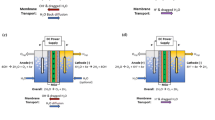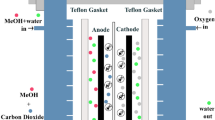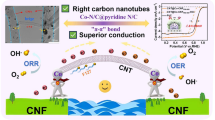Abstract
In this study, a unique multi-scale nanofiber membrane prepared by electrospinning with adding the tetrabutylammonium chloride (TBAC) was applied to proton exchange membrane for direct methanol fuel cell. Three types of multi-scale nanofiber membranes of cellulose acetate (CA), nylon 6 (PA6) and poly-m-phenyleneisophthalamide (PMIA) were carefully selected as effective conductive fillers to be incorporated into Nafion as composite membranes (T-CA-Nafion, T-PA6-Nafion and T-PMIA-Nafion). At 80 °C, the proton conductivity of the multi-scale nanofiber composite membranes could reach 0.192 S cm−1 (T-CA-Nafion), 0.287 S cm−1 (T-PA6-Nafion) and 0.225 S cm−1 (T-PMIA-Nafion), which were higher than that of the ordinary nanofiber composite membrane. At the same time, the methanol permeability was also significantly reduced. The above superiorities could be attributed to the following aspects: Firstly, the unique multi-scale nanofiber structure could provide hierarchically consecutive long-range channels for proton conducting. Meanwhile, the hydrophilicity of TBAC additives made the membrane with high water-absorbing capacity, which could be beneficial to provide more water molecule carriers for proton conduction via the Vehicle mechanism. Moreover, the cross-linked nanofiber network can be acted as barriers to further hinder methanol penetration. Specifically, the –NH (amido bonds in the PA6 and PMIA) groups could be interconnected with –SO3H groups in Nafion matrix via electrostatic attractions, leading to the formation of effective –NH…–SO3H pairs in the composite membrane. The effective acid–base pairs can facilitate the proton hopping through Grotthuss mechanism, which also well illustrated the better proton conducting behavior of the T-PA6-Nafion and T-PMIA-Nafion membranes.















Similar content being viewed by others
References
Ahn M-K, Lee S-B, Min C-M, Yu Y-G, Jang J, Gim M-Y, Lee J-S (2017) Enhanced proton conductivity at low humidity of proton exchange membranes with triazole moieties in the side chains. J Membr Sci 523:480–486. https://doi.org/10.1016/j.memsci.2016.10.018
Chen M, Xiao C, Wang C, Liu H, Huang N (2018) Preparation and characterization of a novel thermally stable thin film composite nanofiltration membrane with poly (m-phenyleneisophthalamide) (PMIA) substrate. J Membr Sci 550:36–44
Chen X, Ma G, Sun W, Dai H, Xiao D, Zhang Y, Qin X, Liu Y, Bu Y (2014) Water promoting electron hole transport between tyrosine and cysteine in proteins via a special mechanism: double proton coupled electron transfer. J Am Chem Soc 136:4515–4524. https://doi.org/10.1021/ja406340z
Deluca N, Elabd Y (2006) Nafion®/poly(vinyl alcohol) blends: effect of composition and annealing temperature on transport properties. J Membr Sci 282:217–224. https://doi.org/10.1016/j.memsci.2006.05.025
Deng N, Wang Y, Yan J, Ju J, Li Z, Fan L, Zhao H, Kang W, Cheng B (2017) A F-doped tree-like nanofiber structural poly-m-phenyleneisophthalamide separator for high-performance lithium-sulfur batteries. J Power Sources 362:243–249. https://doi.org/10.1016/j.jpowsour.2017.07.047
Etuk SS, Lawan I, Zhou W, Jiang Y, Zhang Q, Wei X, Zhang M, Fernando GF, Yuan Z (2020) Synthesis and characterization of triazole based sulfonated nanocrystalline cellulose proton conductor. Cellulose 27:3197–3209. https://doi.org/10.1007/s10570-020-02981-6
Feng S, Shen K, Wang Y, Pang J, Jiang Z (2013) Concentrated sulfonated poly (ether sulfone)s as proton exchange membranes. J Power Sources 224:42–49. https://doi.org/10.1016/j.jpowsour.2012.09.071
Friedman AK, Shi W, Losovyj Y, Siedle AR, Baker LA (2018) Mapping microscale chemical heterogeneity in nafion membranes with X-ray photoelectron spectroscopy. J Electrochem Soc 165:H733–H741. https://doi.org/10.1149/2.0771811jes
Gao L, Li J, Ju J, Cheng B, Kang W, Deng N (2021) High-performance all-solid-state polymer electrolyte with fast conductivity pathway formed by hierarchical structure polyamide 6 nanofiber for lithium metal battery. J Energy Chem 54:644–654. https://doi.org/10.1016/j.jechem.2020.06.035
Garaev V, Pavlovica S, Reinholds I, Vaivars G (2013) Mechanical properties and XRD of Nafion modified by 2-hydroxyethylammonium ionic liquids. IOP conference series: materials science and engineering, vol 49. https://doi.org/10.1088/1757-899x/49/1/012058
Gong X, He G, Wu Y, Zhang S, Chen B, Dai Y, Wu X (2017) Aligned electrospun nanofibers as proton conductive channels through thickness of sulfonated poly (phthalazinone ether sulfone ketone) proton exchange membranes. J Power Sources 358:134–141. https://doi.org/10.1016/j.jpowsour.2017.05.022
Guo Y, Jiang Z, Ying W, Chen L, Liu Y, Wang X, Jiang Z, Chen B, Peng X (2018) A DNA-threaded ZIF-8 membrane with high proton conductivity and low methanol permeability. Adv Mater 30:10. https://doi.org/10.1002/adma.201705155
He B, Li J, Pan Z (2012) Morphology and mechanical properties of MWNT/PMIA nanofibers by electrospinning. Text Res J 82:1390–1395. https://doi.org/10.1177/0040517512441990
He C, Mighri F, Guiver MD, Kaliaguine S (2016) Tuning surface hydrophilicity/hydrophobicity of hydrocarbon proton exchange membranes (PEMs). J Colloid Interface Sci 466:168–177. https://doi.org/10.1016/j.jcis.2015.12.023
Jiang ZJ, Jiang Z, Tian X, Luo L, Liu M (2017) Sulfonated holey graphene oxide (SHGO) filled sulfonated poly(ether ether ketone) membrane: the role of holes in the SHGO in improving its performance as proton exchange membrane for direct methanol fuel cells. ACS Appl Mater Interfaces 9:20046–20056. https://doi.org/10.1021/acsami.7b00198
Jiang Y, Lawan I, Zhou W, Zhang M, Fernando GF, Wang L, Yuan Z (2019) Synthesis, properties and photocatalytic activity of a semiconductor/cellulose composite for dye degradation-a review. Cellulose 27:595–609. https://doi.org/10.1007/s10570-019-02851-w
John A, Chen Y, Kim J (2012) Synthesis and characterization of cellulose acetate–calcium carbonate hybrid nanocomposite. Compos B Eng 43:522–525. https://doi.org/10.1016/j.compositesb.2011.08.021
Ju J, Kang W, Deng N, Li L, Zhao Y, Ma X, Fan L, Cheng B (2017a) Preparation and characterization of PVA-based carbon nanofibers with honeycomb-like porous structure via electro-blown spinning method. Microporous Mesoporous Mater 239:416–425. https://doi.org/10.1016/j.micromeso.2016.10.024
Ju J, Shi Z, Deng N, Liang Y, Kang W, Cheng B (2017b) Designing waterproof breathable material with moisture unidirectional transport characteristics based on a TPU/TBAC tree-like and TPU nanofiber double-layer membrane fabricated by electrospinning. RSC Adv 7:32155–32163. https://doi.org/10.1039/c7ra04843b
Jung HY, Roh SH (2020) Polyvinylidene fluoride nanofiber composite membrane coated with perfluorinated sulfuric acid for microbial fuel cell application. J Nanosci Nanotechnol 20:5711–5715. https://doi.org/10.1166/jnn.2020.17622
Kallem P, Yanar N, Choi H (2018) Nanofiber-based proton exchange membranes: development of aligned electrospun nanofibers for polymer electrolyte fuel cell applications. ACS Sustain Chem Eng 7:1808–1825. https://doi.org/10.1021/acssuschemeng.8b03601
Kang W, Ju J, Zhao H, Li Z, Ma X, Cheng B (2017) Characterization and antibacterial properties of Ag NPs doped nylon 6 tree-like nanofiber membrane prepared by one-step electrospinning. Fibers Polym 17:2006–2013. https://doi.org/10.1007/s12221-016-6821-0
Li Z, Xu Y, Fan L, Kang W, Cheng B (2016) Fabrication of polyvinylidene fluoride tree-like nanofiber via one-step electrospinning. Mater Des 92:95–101. https://doi.org/10.1016/j.matdes.2015.12.037
Liu G, Tsen W, Jang S, Hu F, Zhong F, Liu H, Wang G, Wen S, Zheng G, Gong C (2019) Mechanically robust and highly methanol-resistant sulfonated poly(ether ether ketone)/poly(vinylidene fluoride) nanofiber composite membranes for direct methanol fuel cells. J Membr Sci 591:15. https://doi.org/10.1016/j.memsci.2019.117321
Liu X, Yang Z, Zhang Y, Li C, Dong J, Liu Y, Cheng H (2017) Electrospun multifunctional sulfonated carbon nanofibers for design and fabrication of SPEEK composite proton exchange membranes for direct methanol fuel cell application. Int J Hydrogen Energy 42:10275–10284. https://doi.org/10.1016/j.ijhydene.2017.02.128
Lue SJ, Chen WW, Wu SY, Wang LD, Kuo CH (2008) Vapor permeation modeling of multi-component systems using a poly(dimethylsiloxane) membrane. J Membr Sci 311:380–389. https://doi.org/10.1016/j.memsci.2008.01.001
Mi L, Wang H, Zhang Y, Yao X, Chang Y, Li G, Li G, Jiang Y (2017) High performance visible-near-infrared PbS-quantum-dots/indium Schottky diodes for photodetectors. Nanotechnology 28:055202. https://doi.org/10.1088/1361-6528/28/5/055202
Mu JQ, Yang Y, Peng ZH (2011) Preparation and characterization of a novel flame retarded MCA-PA6 resin by In Situ polymerization. Adv Mater Res 399–401:444–448
Nasir M, Subhan A, Prihandoko B, Lestariningsih T (2017) Nanostructure and property of electrospun SiO2-cellulose acetate nanofiber composite by electrospinning. Energy Procedia 107:227–231. https://doi.org/10.1016/j.egypro.2016.12.133
Peckham TJ, Holdcroft S (2010) Structure-morphology-property relationships of non-perfluorinated proton-conducting membranes. Adv Mater 22:4667–4690. https://doi.org/10.1002/adma.201001164
Qureshi UA, Khatri Z, Ahmed F, Ibupoto AS, Khatri M, Mahar FA, Brohi RZ, Kim IS (2017) Highly efficient and robust electrospun nanofibers for selective removal of acid dye. J Mol Liq 244:478–488. https://doi.org/10.1016/j.molliq.2017.08.129
Ru C, Gu Y, Duan Y, Zhao C, Na H (2019) Enhancement in proton conductivity and methanol resistance of Nafion membrane induced by blending sulfonated poly(arylene ether ketones) for direct methanol fuel cells. J Membr Sci 573:439–447. https://doi.org/10.1016/j.memsci.2018.12.030
Shabani I, Hasani-Sadrabadi MM, Haddadi-Asl V, Soleimani M (2011) Nanofiber-based polyelectrolytes as novel membranes for fuel cell applications. J Membr Sci 368:233–240. https://doi.org/10.1016/j.memsci.2010.11.048
Sood R, Cavaliere S, Jones DJ, Rozière J (2016) Electrospun nanofibre composite polymer electrolyte fuel cell and electrolysis membranes. Nano Energy 26:729–745. https://doi.org/10.1016/j.nanoen.2016.06.027
Sproll V, Schmidt TJ, Gubler L (2018) Effect of glycidyl methacrylate (GMA) incorporation on water uptake and conductivity of proton exchange membranes. Radiat Phys Chem 144:276–279. https://doi.org/10.1016/j.radphyschem.2017.08.025
Sun H, Tang B, Wu P (2017) Two-dimensional zeolitic imidazolate framework/carbon nanotube hybrid networks modified proton exchange membranes for improving transport properties. ACS Appl Mater Interfaces 9:35075–35085. https://doi.org/10.1021/acsami.7b13013
Thiam HS, Daud WRW, Kamarudin SK, Mohamad AB, Kadhum AAH, Loh KS, Majlan EH (2013) Nafion/Pd–SiO2 nanofiber composite membranes for direct methanol fuel cell applications. Int J Hydrogen Energy 38:9474–9483. https://doi.org/10.1016/j.ijhydene.2012.11.141
Vijayalekshmi V, Khastgir D (2017) Chitosan/partially sulfonated poly(vinylidene fluoride) blends as polymer electrolyte membranes for direct methanol fuel cell applications. Cellulose 25:661–681. https://doi.org/10.1007/s10570-017-1565-6
Vinothkannan M, Kim AR, Gnana KG, Yoon J-M, Yoo DJ (2017) Toward improved mechanical strength, oxidative stability and proton conductivity of an aligned quadratic hybrid (SPEEK/FPAPB/Fe3O4-FGO) membrane for application in high temperature and low humidity fuel cells. RSC Adv 7:39034–39048. https://doi.org/10.1039/c7ra07063b
Wang H, Li X, Zhuang X, Cheng B, Wang W, Kang W, Shi L, Li H (2017a) Modification of Nafion membrane with biofunctional SiO2 nanofiber for proton exchange membrane fuel cells. J Power Sources 340:201–209. https://doi.org/10.1016/j.jpowsour.2016.11.072
Wang H, Tang C, Zhuang X, Cheng B, Wang W, Kang W, Li H (2017b) Novel structure design of composite proton exchange membranes with continuous and through-membrane proton-conducting channels. J Power Sources 365:92–97. https://doi.org/10.1016/j.jpowsour.2017.08.072
Wang J, Li P, Zhang Y, Liu Y, Wu W, Liu J (2019a) Porous Nafion nanofiber composite membrane with vertical pathways for efficient through-plane proton conduction. J Membr Sci 585:157–165. https://doi.org/10.1016/j.memsci.2019.05.041
Wang J, Shih PC, Wu Y, Carroll JM (2015) Comparative case studies of open source software peer review practices. Inf Softw Technol 67:1–12. https://doi.org/10.1016/j.infsof.2015.06.002
Wang L, Deng N, Liang Y, Ju J, Cheng B, Kang W (2020a) Metal-organic framework anchored sulfonated poly(ether sulfone) nanofibers as highly conductive channels for hybrid proton exchange membranes. J Power Sources 450:10. https://doi.org/10.1016/j.jpowsour.2019.227592
Wang L, Deng N, Wang G, Ju J, Cheng B, Kang W (2019b) Constructing amino-functionalized flower-like metal-organic framework nanofibers in sulfonated poly(ether sulfone) proton exchange membrane for simultaneously enhancing interface compatibility and proton conduction. ACS Appl Mater Interfaces 11:39979–39990. https://doi.org/10.1021/acsami.9b13496
Wang L, Deng N, Wang G, Ju J, Wang M, Cheng B, Kang W (2020b) Construction of interpenetrating transport channels and compatible interfaces via a zeolitic imidazolate framework “bridge” for nanofibrous hybrid PEMs with enhanced proton conduction and methanol resistance. ACS Sustain Chem Eng 8:12976–12989. https://doi.org/10.1021/acssuschemeng.0c03833
Wang S-H, Lin H-L (2014) Poly (vinylidene fluoride-co-hexafluoropropylene)/polybenzimidazole blend nanofiber supported Nafion membranes for direct methanol fuel cells. J Power Sources 257:254–263. https://doi.org/10.1016/j.jpowsour.2014.01.104
Wang S, Shi L, Zhang S, Wang H, Cheng B, Zhuang X, Li Z (2019c) Proton-conducting amino acid-modified chitosan nanofibers for nanocomposite proton exchange membranes. Eur Polym J 119:327–334. https://doi.org/10.1016/j.eurpolymj.2019.07.041
Wei M, Jiang M, Liu X, Wang M, Mu S (2016) Graphene-doped electrospun nanofiber membrane electrodes and proton exchange membrane fuel cell performance. J Power Sources 327:384–393. https://doi.org/10.1016/j.jpowsour.2016.07.083
Wei Y, Shen L, Wang F, Yang W-D, Zhu H, Wang Z, Han K (2011) Synthesis and characterization of novel nanocomposite membrane of sodium titanate/Nafion®. Mater Lett 65:1684–1687. https://doi.org/10.1016/j.matlet.2011.02.081
Wu H, Cao Y, Li Z, He G, Jiang Z (2015) Novel sulfonated poly (ether ether ketone)/phosphonic acid-functionalized titania nanohybrid membrane by an in situ method for direct methanol fuel cells. J Power Sources 273:544–553. https://doi.org/10.1016/j.jpowsour.2014.09.134
Xia X, Dong XJ, Wei QF, Cai YB, Lu KY (2012) Formation mechanism of porous hollow SnO2 nanofibers prepared by one-step electrospinning. Express Polym Lett 6:169–176. https://doi.org/10.3144/expresspolymlett.2012.18
Xie K, Shen J, Ye L, Liu Z, Li Y (2019) Increased gt conformer contents of PLLA molecular chains induced by Li-TFSI in melt: another route to promote PLLA crystallization. Macromolecules 52:7065–7072. https://doi.org/10.1021/acs.macromol.9b01188
Xu X, Li L, Wang H, Li X, Zhuang X (2015) Solution blown sulfonated poly(ether ether ketone) nanofiber–Nafion composite membranes for proton exchange membrane fuel cells. RSC Adv 5:4934–4940. https://doi.org/10.1039/c4ra10898a
Xu X, Li R, Tang C, Wang H, Zhuang X, Liu Y, Kang W, Shi L (2018) Cellulose nanofiber-embedded sulfonated poly (ether sulfone) membranes for proton exchange membrane fuel cells. Carbohydr Polym 184:299–306. https://doi.org/10.1016/j.carbpol.2017.12.074
Yang JM, Zha LS, Yu DG, Liu J (2013) Coaxial electrospinning with acetic acid for preparing ferulic acid/zein composite fibers with improved drug release profiles. Colloids Surf B Biointerfaces 102:737–743. https://doi.org/10.1016/j.colsurfb.2012.09.039
Yao Y, Guo B, Ji L, Jung K-H, Lin Z, Alcoutlabi M, Hamouda H, Zhang X (2011) Highly proton conductive electrolyte membranes: Fiber-induced long-range ionic channels. Electrochem Commun 13:1005–1008. https://doi.org/10.1016/j.elecom.2011.06.028
Zhang B, Cao Y, Jiang S, Li Z, He G, Wu H (2016) Enhanced proton conductivity of Nafion nanohybrid membrane incorporated with phosphonic acid functionalized graphene oxide at elevated temperature and low humidity. J Membr Sci 518:243–253. https://doi.org/10.1016/j.memsci.2016.07.032
Zhang J, Tsuji H, Noda I, Ozaki Y (2004) Weak intermolecular interactions during the melt crystallization of poly(l-lactide) investigated by two-dimensional infrared correlation spectroscopy. J Phys Chem B 108:11514–11520. https://doi.org/10.1021/jp048308q
Zhang K, Li Z, Deng N, Ju J, Li Y, Cheng B, Kang W, Yan J (2018) Tree-like cellulose nanofiber membranes modified by citric acid for heavy metal ion (Cu2+) removal. Cellulose 26:945–958. https://doi.org/10.1007/s10570-018-2138-z
Zhang L, Chae S-R, Hendren Z, Park J-S, Wiesner MR (2012) Recent advances in proton exchange membranes for fuel cell applications. Chem Eng J 204–206:87–97. https://doi.org/10.1016/j.cej.2012.07.103
Zhao G, Xu X, Shi L, Cheng B, Zhuang X (2020a) Bio-analogue l-lysine lined arrangement on nanofibers with superior proton-conduction for proton exchange membrane. Solid State Ionics. https://doi.org/10.1016/j.ssi.2020.115289
Zhao G, Xu X, Shi L, Cheng B, Zhuang X, Yin Y (2020b) Biofunctionalized nanofiber hybrid proton exchange membrane based on acid-base ion-nanochannels with superior proton conductivity. J Power Sources 452:11. https://doi.org/10.1016/j.jpowsour.2020.227839
Zhao G, Xu X, Zhao H, Shi L, Zhuang X, Cheng B, Yin Y (2020c) Zeolitic imidazolate framework decorated on 3D nanofiber network towards superior proton conduction for proton exchange membrane. J Membr Sci 601:13. https://doi.org/10.1016/j.memsci.2020.117914
Zhao H, Deng N, Kang W, Li Z, Wang G, Cheng B (2020d) Highly multiscale structural Poly(vinylidene fluoridehexafluoropropylene) / poly-m-phenyleneisophthalamide separator with enhanced interface compatibility and uniform lithium-ion flux distribution for dendrite-proof lithium-metal batteries. Energy Storage Mater 26:334–348. https://doi.org/10.1016/j.ensm.2019.11.005
Zhao H, Kang W, Ma X, Deng N, Li Z, Cheng B (2017) Fabrication and catalytic behavior of hierarchically-structured nylon 6 nanofiber membrane decorated with silver nanoparticles. Chin J Catal 38:73–82. https://doi.org/10.1016/s1872-2067(16)62545-7
Zhao H, Yan J, Deng N, Kang W, Cheng B (2021) A versatile nano-TiO2 decorated gel separator with derived multi-scale nanofibers towards dendrite-blocking and polysulfide-inhibiting lithium-metal batteries. J Energy Chem 55:190–201. https://doi.org/10.1016/j.jechem.2020.07.015
Zhao J, Dehbari N, Han W, Huang L, Tang Y (2015) Electrospun multi-scale hybrid nanofiber/net with enhanced water swelling ability in rubber composites. Mater Des 86:14–21. https://doi.org/10.1016/j.matdes.2015.07.105
Zhou W, Sun S, Jiang Y, Zhang M, Lawan I, Fernando GF, Wang L, Yuan Z (2019) Template in situ synthesis of flower-like BiOBr/microcrystalline cellulose composites with highly visible-light photocatalytic activity. Cellulose 26:9529–9541. https://doi.org/10.1007/s10570-019-02722-4
Acknowledgments
The author would like to thank the National Natural Science Foundation of China (51873152), the Natural Science Foundation of Tianjin (No. 18JCQNJC76900), the Science and Technology Plans of Tianjin (Nos. 17PTSYJC00040, 18PTSYJC00180 and 19PTSYJC00010) for their financial supports.
Author information
Authors and Affiliations
Corresponding authors
Ethics declarations
Conflict of interest
The authors declare no competing financial interest.
Additional information
Publisher's Note
Springer Nature remains neutral with regard to jurisdictional claims in published maps and institutional affiliations.
Supplementary Information
Below is the link to the electronic supplementary material.
Rights and permissions
About this article
Cite this article
Wang, M., Wang, L., Deng, N. et al. Electrospun multi-scale nanofiber network: hierarchical proton-conducting channels in Nafion composite proton exchange membranes. Cellulose 28, 6567–6585 (2021). https://doi.org/10.1007/s10570-021-03843-5
Received:
Accepted:
Published:
Issue Date:
DOI: https://doi.org/10.1007/s10570-021-03843-5




